 As well as the "writing evoked by objects in the Wellcome collection" (the little book) there were the nests for panacea-pills, and their boxes. The velvet moneybags were lined with silk, on which was printed a selection of "what ails society" -
As well as the "writing evoked by objects in the Wellcome collection" (the little book) there were the nests for panacea-pills, and their boxes. The velvet moneybags were lined with silk, on which was printed a selection of "what ails society" - Like the Goa stone that had little hand-written label, my stones had labels that I hoped would "explain" them, and link with the words in the bags -
Like the Goa stone that had little hand-written label, my stones had labels that I hoped would "explain" them, and link with the words in the bags - Here are the three (a resonant number?), carrying their sad secrets -
Here are the three (a resonant number?), carrying their sad secrets -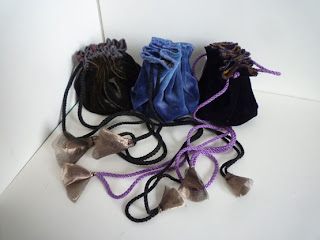
We each had half an hour to present and get feedback on our work - and what a range there was.
In addition to a book "made from ordinary materials" with just text, no images, Chris made a small portfolio with fragile images printed on tissue paper bursting out, interpersed with text about the objects he'd been looking at, from the descriptions on their labels, which he printed on tarot cards -
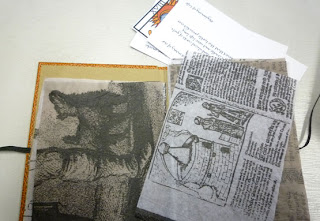
Karen's choice of objects led to work about touch. She provided gloves for touching the glass with its dangerous edges. Text was untouchable - in between the layers of glass. The series not shown consisted of 5-line poems, gogyoka, in black lettering.


To read Carolina's text, you had to dig around, or pick up and turn the intriguing objects, and make your own connections between the phrases in their various locations -
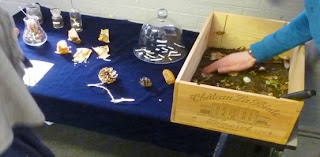

Janet's dark womb-book contained an umbilical cord of words printed on fabric
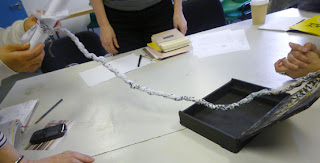 but the more interesting part was the scroll of words it was gestating - she said she was mesmerized by typing the repetitive patterns, like the gene sequence in DNA. She made some words red and read out that selected text -
but the more interesting part was the scroll of words it was gestating - she said she was mesmerized by typing the repetitive patterns, like the gene sequence in DNA. She made some words red and read out that selected text -

 but the more interesting part was the scroll of words it was gestating - she said she was mesmerized by typing the repetitive patterns, like the gene sequence in DNA. She made some words red and read out that selected text -
but the more interesting part was the scroll of words it was gestating - she said she was mesmerized by typing the repetitive patterns, like the gene sequence in DNA. She made some words red and read out that selected text -
I'm not sure if explaining the evolution of my own project made me understand it better, or think more clearly about where (if anywhere) it might be going. People said that without the introduction they wouldn't have realised what it was about. Opinion was divided on whether just one big stone, with its label, was better than lots of little stones (which look more like coins in the moneybag. Holding the big stone, with its relation to "the earth", also had the message of looking after nature/the earth. Mixed messages, then - not good. I'm pleased with the objects as such, but they don't work as intended. Back to the drawing board - but from a different place, with a different background and therefore a changed set of possibilities. I was glad for the exposure to systems of deriving text, and being able to consider it as a material to be manipulated - it's just not as comfortable to do so as to devise objects ... yet ...
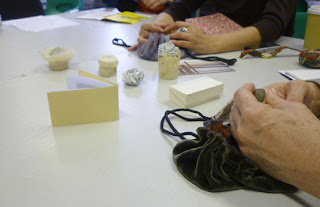
[27 April – After showing the bags again to Karen and Janet and getting their further thoughts, I now might go ahead and make two more bags for the “Five by five” show we three, plus Chris and Carolina – the part-timers – will be holding soon at college.
Having two more moneybags would make five similar bags – perhaps with different contents – and they could be displayed in different ways, eg a group hanging, and a couple lying open so that the writing could be read.
Again, though, the problem still to be resolved is whether these are simply “nice objects” that have appeal and perhaps resonance because they are made of tactile velvet and have harmonious colours and hang or sit “nicely” – or can people who don’t know the story of goa stones “read” something into the objects/display?
This is wher ethe right title will be make all the difference. One of the important ideas involved, for me, was that “throwing money at it” was believed to be the way of solving today’s problems. A stone isn’t money, but it’s something you might throw...]

[27 April – After showing the bags again to Karen and Janet and getting their further thoughts, I now might go ahead and make two more bags for the “Five by five” show we three, plus Chris and Carolina – the part-timers – will be holding soon at college.
Having two more moneybags would make five similar bags – perhaps with different contents – and they could be displayed in different ways, eg a group hanging, and a couple lying open so that the writing could be read.
Again, though, the problem still to be resolved is whether these are simply “nice objects” that have appeal and perhaps resonance because they are made of tactile velvet and have harmonious colours and hang or sit “nicely” – or can people who don’t know the story of goa stones “read” something into the objects/display?
This is wher ethe right title will be make all the difference. One of the important ideas involved, for me, was that “throwing money at it” was believed to be the way of solving today’s problems. A stone isn’t money, but it’s something you might throw...]
Susan brought along some books to pursue in terms of deriving/devising text: Nets by Jen Bervin; Crystallography by Christian Bok; Exercises in Style by Raymond Queneau; Eclat by Caroline Bergvall; Dictee by Theresa Hak Kyung Cha; Energies of Writing by Aaron Williamson and Tertia Longmire; Hearing Things by Aaron Williamson.
After the seminar, much hilarity thinking up titles for the "fringe" show we'll be having alongside the degree show in September. (Meanwhile the full-timers were finishing writing their essays, due the next day.)
 and screen printing was a hive of activity -
and screen printing was a hive of activity -

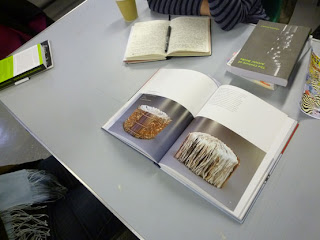 You can "look inside" the book here; my personal selection of interesting pages is below (click to enlarge)
You can "look inside" the book here; my personal selection of interesting pages is below (click to enlarge)
 The practioners' lecture was by one half of the design duo Committee. He told of how they decided to learn skills after taking a fine art degree (machine knitting and cabinet making) and sell products "in the normal world" rather than as Art, ghettoized into an elite market. This led to looking at what "the high street" means and what decisions are made by designers - informed (thanks to their fine art training) by a distrust of everything. Starting from first principles every time, they ask "why are things the shape they are".
The practioners' lecture was by one half of the design duo Committee. He told of how they decided to learn skills after taking a fine art degree (machine knitting and cabinet making) and sell products "in the normal world" rather than as Art, ghettoized into an elite market. This led to looking at what "the high street" means and what decisions are made by designers - informed (thanks to their fine art training) by a distrust of everything. Starting from first principles every time, they ask "why are things the shape they are".
This week Camberwell's foundation course students are setting up their show, so the corridor on the way to the textile printing room was a bit of an obstacle course
 and screen printing was a hive of activity -
and screen printing was a hive of activity -
The reading group on Wednesday was scheduled to discuss another chapter from "The Century of Artists Books" - but none of us had finished reading the chapter (is this a bad omen?). Instead we looked at The Book as Art: Artists' Books from the National Museum of Women in the Arts by Krystyna Wasserman, Johanna Drucker, and Audrey Niffenegger.
 You can "look inside" the book here; my personal selection of interesting pages is below (click to enlarge)
You can "look inside" the book here; my personal selection of interesting pages is below (click to enlarge) The practioners' lecture was by one half of the design duo Committee. He told of how they decided to learn skills after taking a fine art degree (machine knitting and cabinet making) and sell products "in the normal world" rather than as Art, ghettoized into an elite market. This led to looking at what "the high street" means and what decisions are made by designers - informed (thanks to their fine art training) by a distrust of everything. Starting from first principles every time, they ask "why are things the shape they are".
The practioners' lecture was by one half of the design duo Committee. He told of how they decided to learn skills after taking a fine art degree (machine knitting and cabinet making) and sell products "in the normal world" rather than as Art, ghettoized into an elite market. This led to looking at what "the high street" means and what decisions are made by designers - informed (thanks to their fine art training) by a distrust of everything. Starting from first principles every time, they ask "why are things the shape they are".Thursday was a long day of screen printing - some of the pages from my A2-sized pad of 25 pages are finished, and others still need work. I laid them out, two pages at a time, to photograph the front and back of each sheet -
 Much easier to photograph by using a tripod -
Much easier to photograph by using a tripod -
 Here are a couple at closer range -
Here are a couple at closer range -

 I think I've lost my way with this - through being too careful about what goes where, and through filling the pages too much. What worked better was printing just one smaller page, in the middle of a screen, and having the borders printed onto the A2 sheets. Perhaps the next sequence will be about these kinds of "windows". I'm hoping to finish this set in the next couple of weeks (and then comes the decision of how to put them together....)
I think I've lost my way with this - through being too careful about what goes where, and through filling the pages too much. What worked better was printing just one smaller page, in the middle of a screen, and having the borders printed onto the A2 sheets. Perhaps the next sequence will be about these kinds of "windows". I'm hoping to finish this set in the next couple of weeks (and then comes the decision of how to put them together....)
 Much easier to photograph by using a tripod -
Much easier to photograph by using a tripod - Here are a couple at closer range -
Here are a couple at closer range -
 I think I've lost my way with this - through being too careful about what goes where, and through filling the pages too much. What worked better was printing just one smaller page, in the middle of a screen, and having the borders printed onto the A2 sheets. Perhaps the next sequence will be about these kinds of "windows". I'm hoping to finish this set in the next couple of weeks (and then comes the decision of how to put them together....)
I think I've lost my way with this - through being too careful about what goes where, and through filling the pages too much. What worked better was printing just one smaller page, in the middle of a screen, and having the borders printed onto the A2 sheets. Perhaps the next sequence will be about these kinds of "windows". I'm hoping to finish this set in the next couple of weeks (and then comes the decision of how to put them together....)
No comments:
Post a Comment